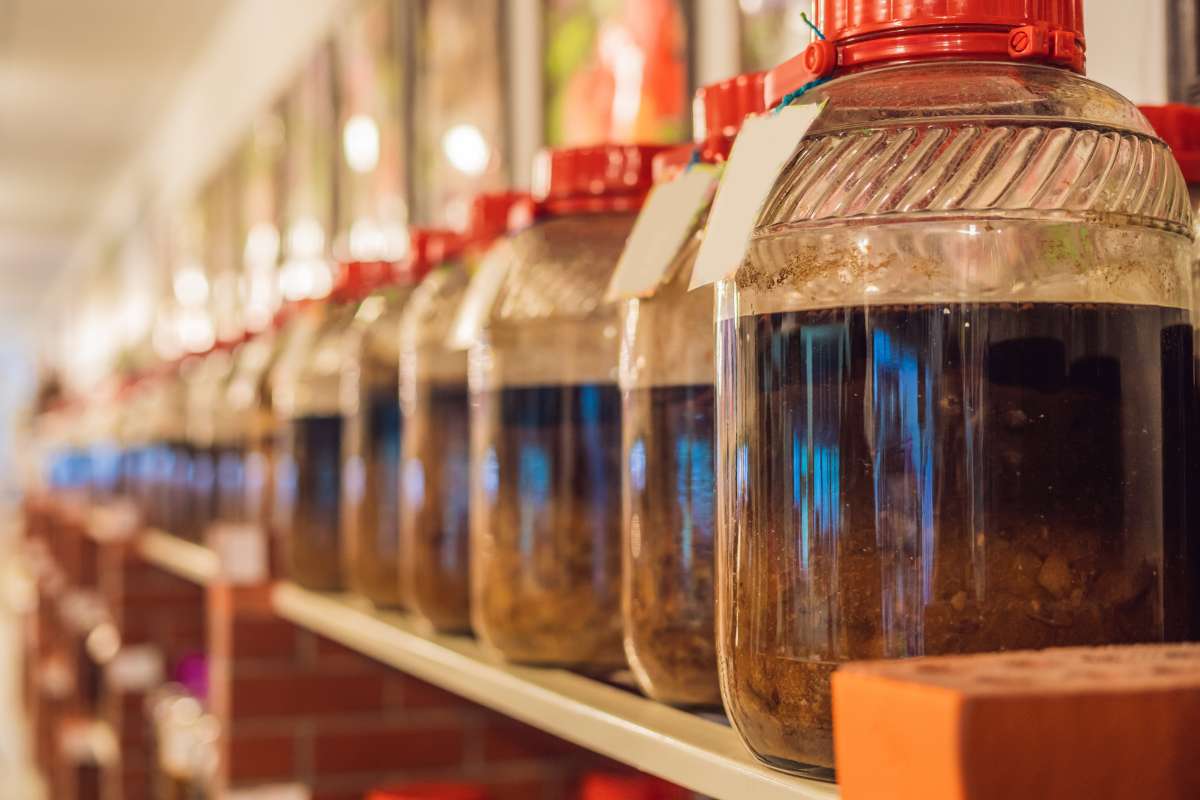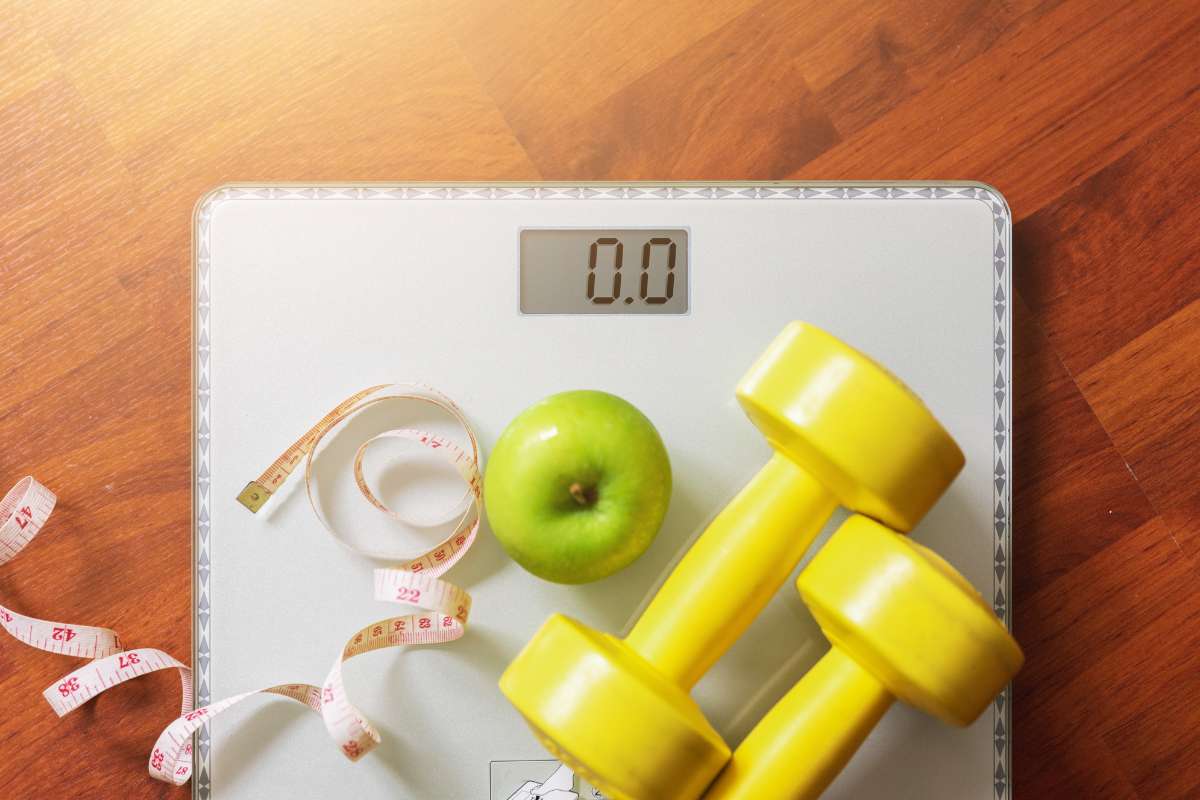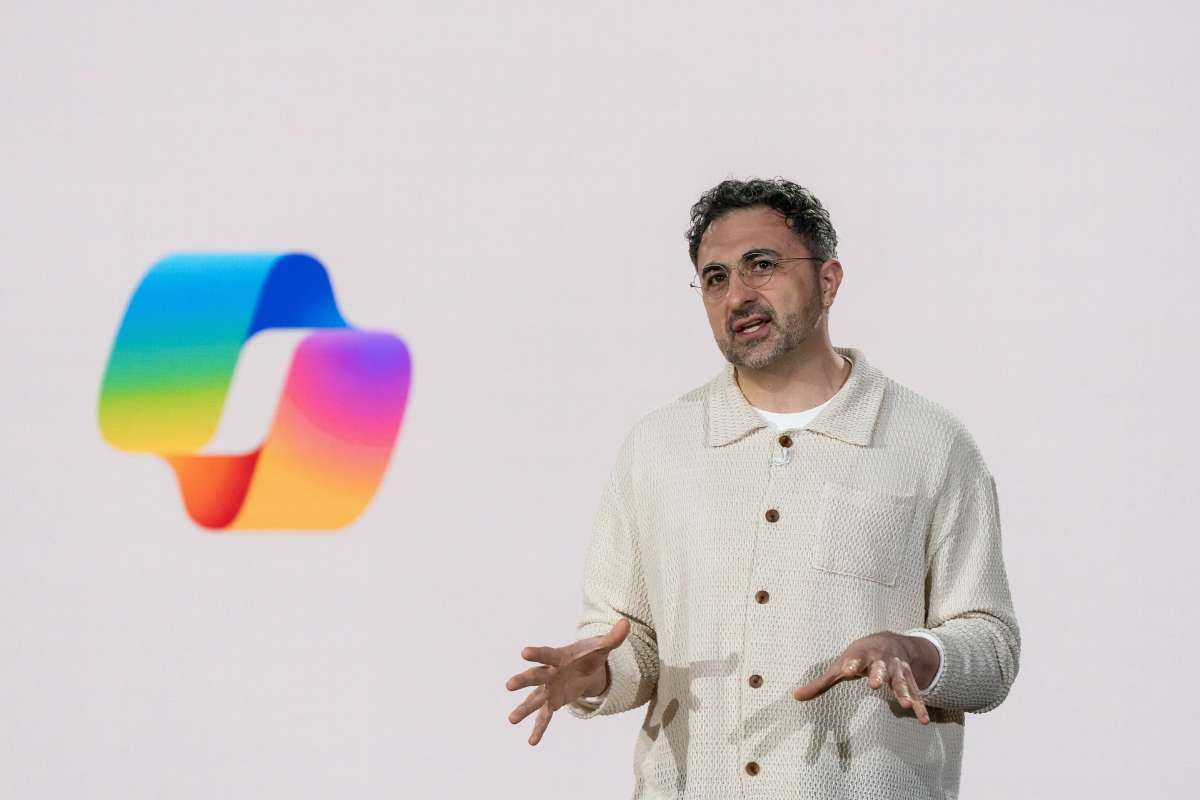Have you ever wished you could sleep better, focus more, or recover faster after a workout without relying on luck or guesswork? That’s exactly what biohacking is all about. It’s the art (and science) of using data, technology, and simple lifestyle tweaks to optimise your body and mind.
And you’re not alone. Recent surveys show that nearly one in three Americans is experimenting with some types of biohacking.
The idea is simple: by understanding your own biology, you can make smarter choices that actually work. Some people are using wearables to monitor heart rate, others are experimenting with intermittent fasting or supplements, and a few even explore genetic insights.
But while biohacking can bring amazing results, it’s not without its risks. That’s why it’s important to know the different types, categories, and real-life examples before diving in. In this blog, we’ll break it all down, sharing the science, the stories, and the practical ways you can start experimenting safely with biohacking yourself.
Why Biohacking Matters in 2026?
Biohacking has moved from niche communities to mainstream health and wellness, empowering individuals to take control of their own biology with science-backed methods. According to recent surveys, over 67% of Americans engage in some form of biohacking, from monitoring sleep and nutrition to experimenting with cognitive enhancers, highlighting its growing impact on daily life.
➣ Physical Benefits:
Scientific studies support many biohacking techniques for physical health. For example, practices like intermittent fasting, targeted nutrition, and cold exposure have been shown to improve metabolism, reduce inflammation, and enhance recovery. Wearables and fitness trackers provide real-time data on heart rate, sleep quality, and activity, allowing individuals to make evidence-based decisions that optimise performance.
➣ Risks and Ethical Considerations:
While many biohacks are safe and effective, some, like unregulated supplements, DIY genetic experiments, or neural implants, carry potential risks. Ethical concerns, particularly around genetic editing and invasive procedures, highlight the need for caution and responsible experimentation. Understanding the types of biohacking and their evidence-based outcomes is essential for safe practice.
➣ Relevance Today:
As interest in wellness, longevity, and performance grows, biohacking offers a way to make data-driven lifestyle improvements. Awareness of the types of biohacking allows individuals to choose strategies that are safe, effective, and aligned with their personal goals, making it a practical tool for optimising both health and daily performance.
A Look at Every Category of Biohacking:
Biohacking comes in many forms, each targeting different aspects of health, performance, and cognition. Understanding the types of biohacking helps you choose strategies that match your goals.
| Category | Focus Area | Popular Techniques / Tools | Key Benefits |
| Nutritional Biohacking | Diet & metabolism | Intermittent fasting, keto/plant-based diets, supplements | Boosts energy, metabolism, and overall wellness |
| Technological Biohacking | Monitoring & optimization | Smartwatches, sleep trackers, glucose monitors, implants | Enhances sleep, activity, and recovery |
| Genetic & Molecular Biohacking | DNA & molecular level | Gene editing, CRISPR experiments, and DNA-based nutrition | Personalised health optimisation, longevity |
| Neurohacking | Brain & cognition | Nootropics, meditation, neurofeedback, brainwave entrainment | Improves focus, memory, and creativity |
| Fitness & Lifestyle Biohacking | Physical performance | Heart rate monitors, personalised training programs, recovery tools | Optimises workouts, recovery, and energy levels |
| DIY Biology (DIYbio) | Citizen science & experimentation | Home experiments, microbiome testing, safe genetic studies | Hands-on learning, innovation, personalised insights |
These types of biohacking provide a flexible toolkit for improving health, cognition, and performance. Many biohackers combine techniques across categories for a holistic approach to optimising their biology.
Here are the top 10 Types of Biohacking You should know.
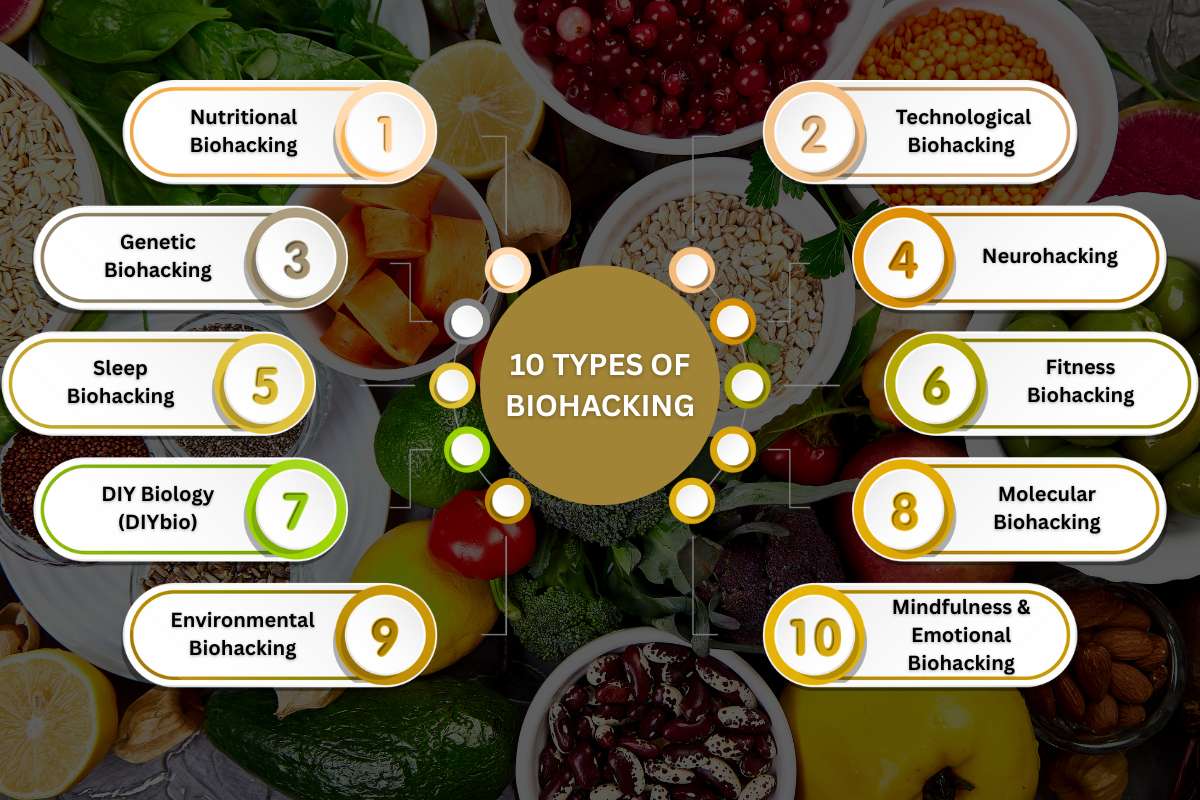
The world of biohacking is vast, but most methods fall under a few core categories. Here’s a breakdown of the 10 most influential types of biohacking, along with their benefits, applications, and relevance today:
1. Nutritional Biohacking
Nutrition is the foundation of most types of biohacking because what you eat directly shapes how your body and mind perform. Nutritional biohacking involves experimenting with diets like intermittent fasting, ketogenic eating, or plant-based nutrition, as well as supplement stacks designed for focus, longevity, and energy.
Studies show that intermittent fasting can improve insulin sensitivity and reduce inflammation, making it one of the most effective and widely adopted methods. By tailoring food choices to biological needs, people can boost metabolism, sharpen mental clarity, and even extend lifespan, all by starting with their plate.
| Complexity | Low |
| Cost | Low |
| Key Benefit | Metabolic & energyoptimisationn |
| Common Tools/Practices | Fasting, supplements, diets |
| Examples | Intermittent fasting, ketogenic diets, plant-based eating, or supplement stacks. |
2. Technological Biohacking
Tech has revolutionised self-optimisation by turning raw health data into actionable insights. Through wearables like the Oura Ring, continuous glucose monitors, or WHOOP bands, users can track everything from blood sugar to sleep stages.
A 2024 report highlighted that 70% of wearable users made at least one long-term lifestyle change based on device feedback. Technological biohacking matters because it shifts wellness from guesswork to precision. With data-backed decisions, people can spot patterns, correct habits, and build a healthier lifestyle supported by real-time feedback rather than trial and error.
| Complexity | Medium |
| Cost | Medium–High |
| Key Benefit | Real-time health tracking |
| Common Tools/Practices | Wearables, apps, sensors |
| Examples | Oura Ring (sleep tracking), continuous glucose monitors, Apple Watch, and WHOOP band. |
3. Genetic Biohacking
Among the more advanced types of biohacking, genetic optimisation personalises health down to your DNA. By analysing genetic markers, individuals can understand predispositions for conditions like heart disease, obesity, or nutrient deficiencies.
Companies like 23andMe have made this accessible, while emerging CRISPR technologies hint at an even bigger future. Research shows tailored fitness and nutrition plans based on DNA can lower obesity risks, making this biohack a game-changer. Genetic biohacking matters because it goes beyond generic advice, empowering people to design lifestyles aligned with their unique biology.
| Complexity | High |
| Cost | High |
| Key Benefit | Personalised health planning |
| Common Tools/Practices | DNA testing kits, CRISPR research |
| Examples | 23andMe, CRISPR-based research, and gene expression optimisation. |
4. Neurohacking
Neurohacking focuses on boosting brain performance and emotional resilience. It includes nootropics like L-theanine and caffeine, brain training apps, neurofeedback, and even non-invasive brain stimulation.
Studies reveal that certain nootropics can enhance memory and focus without the jitters of traditional stimulants. For professionals, students, or creatives, neurohacking is about unlocking peak mental states on demand. It matters because cognitive ability is the driver of modern productivity, and even small gains in focus or memory can lead to big life changes.
| Complexity | Medium |
| Cost | Medium |
| Key Benefit | Cognitive enhancement |
| Common Tools/Practices | Nootropics, neurofeedback |
| Examples | nootropics (smart drugs), neurofeedback, brain stimulation, and meditation apps. |
5. Sleep Biohacking

Sleep is one of the most overlooked yet critical types of biohacking, as it fuels recovery, energy, and mental sharpness. Poor sleep is linked to higher risks of heart disease, obesity, and anxiety. Biohackers use tools like circadian rhythm trackers, blue-light blockers, and smart mattresses to optimise rest.
Neuroscience studies show that improved sleep quality can enhance cognitive performance by 30–40%. Sleep biohacking matters because it’s accessible, cost-effective, and transformative, allowing people to wake up sharper, calmer, and ready to perform at their best.
| Complexity | Low |
| Cost | Low–Medium |
| Key Benefit | Recovery & productivity |
| Common Tools/Practices | Sleep trackers, blue-light filters |
| Examples | blue-light blockers, smart mattresses, circadian rhythm trackers, and melatonin optimisation. |
6. Fitness Biohacking
Fitness biohacking takes exercise beyond “workouts” by blending data and science into training. From HIIT and blood-flow restriction workouts to AI-driven workout apps, the goal is efficiency and precision. Research shows HIIT burns 25–30% more calories in less time compared to steady cardio.
For athletes and fitness enthusiasts, this type of biohacking means achieving peak performance while minimising the risk of injury and overtraining. It matters because smarter training routines can lead to faster gains, better endurance, and longer-term sustainability.
| Complexity | Medium |
| Cost | Low–Medium |
| Key Benefit | Physical performance |
| Common Tools/Practices | HIIT, biomarker tracking |
| Examples | high-intensity interval training (HIIT), blood-flow restriction training, VO₂ max tracking, and AI-driven workout apps. |
7. DIY Biology (DIYbio)
One of the more experimental types of biohacking is DIY biology, where citizen scientists conduct experiments outside traditional labs. This might include microbiome testing, home labs, or genetic tweaks. While controversial, DIYbio communities have been growing worldwide, giving individuals access to tools once reserved for researchers.
It matters because it democratizes science, sparking innovation and discovery at the grassroots level. But it also raises ethical and safety questions, highlighting the fine balance between experimentation and responsibility.
| Complexity | High |
| Cost | Medium–High |
| Key Benefit | Citizen-led innovation |
| Common Tools/Practices | Home labs, microbiome testing |
| Examples | microbiome testing, synthetic biology, small-scale genetic modification. |
8. Molecular Biohacking
Molecular biohacking dives deeper into body chemistry, targeting cellular health through peptides, hormone regulation, and enzyme optimisation. Therapies like NAD+ supplementation have been shown to support mitochondrial function and slow signs of ageing.
Professional athletes and longevity enthusiasts often explore molecular strategies to extend performance and vitality. This type matters because it aims at the cellular foundation of health, unlocking resilience and youthfulness in ways that diet or exercise alone cannot achieve.
| Complexity | High |
| Cost | High |
| Key Benefit | Anti-ageing & cellular health |
| Common Tools/Practices | Peptides, NAD+ therapy |
| Examples | NAD+ therapy, peptide injections, testosterone balancing, targeted supplementation. |
Also Read: Upgrade Your Life: What Is Biohacking And Why Top Performers Rely On It?
9. Environmental Biohacking
Environmental optimisation is one of the simplest yet powerful types of biohacking, focusing on how your surroundings affect your body. This includes light therapy, air purification, grounding mats, cold plunges, and saunas.
Studies found that 2-3 sauna visits per week were associated with a 24% lower death risk, while 4-7 times per week led to a 40% lower death risk. Environmental biohacking matters because it’s about creating external conditions that naturally boost mood, immunity, and longevity, proving that small tweaks in your space can create big shifts in your health.
| Complexity | High |
| Cost | High |
| Key Benefit | Anti-ageing & cellular health |
| Common Tools/Practices | Peptides, NAD+ therapy |
| Examples | light therapy, air purification, grounding mats, cold exposure, and heat therapy (saunas). |
10. Mindfulness & Emotional Biohacking
Mental well-being is the glue that holds every biohack together. Emotional biohacking incorporates meditation, breathwork, gratitude journaling, and visualisation to train the brain for resilience and positivity.
A Harvard study found mindfulness can shrink the amygdala, the brain’s stress centre, after just eight weeks of practice. This type matters because mental clarity doesn’t just improve mood; it strengthens focus, productivity, and long-term health. Unlike tech-heavy hacks, it’s low-cost yet profoundly transformative, showing that the mind can be biohacked as effectively as the body.
| Complexity | Low |
| Cost | Low |
| Key Benefit | Mental clarity & stress relief |
| Common Tools/Practices | Meditation, breathwork, journaling |
| Examples | meditation, gratitude journaling, breathwork, and visualisation techniques. |
Case Studies: Real-World Biohacking Success
Biohacking may sound futuristic, but countless real-world examples prove how effective and transformative it can be. From individuals unlocking peak performance to startups redefining health, these stories show the practical impact of different types of biohacking in action.
1. Enhanced Cognition Through Biohacking

One of the most talked-about figures in the biohacking community is Dave Asprey, founder of Bulletproof. By experimenting with diet, supplements, and lifestyle hacks, he claims to have improved his focus, reversed chronic fatigue, and even set a goal to live until at least 180. His signature Bulletproof Coffee, a blend of coffee, MCT oil, and butter, sparked a global movement in nutritional biohacking.
Another example is Ben Greenfield, an endurance athlete and coach who uses nootropics, red-light therapy, and biomarker tracking to enhance mental and physical performance. His approach demonstrates how various types of biohacking can complement each other to create holistic optimisation.
2. Startups and Companies Leading the Way
The biohacking movement has grown into a multibillion-dollar industry, with startups and companies offering tools that make self-optimisation more accessible:
- Levels Health: Provides continuous glucose monitoring for everyday users, helping people understand how their diet affects blood sugar in real time.
- Eight Sleep: A sleep-tech company that designs smart mattresses to regulate temperature and track recovery.
- Thorne & Elysium Health: Develop supplements like NAD+ boosters and nootropics for cellular health and longevity.
These companies highlight how biohacking is no longer fringe; it’s becoming mainstream, with data-driven solutions improving lives at scale. Many of their innovations directly link to the most popular types of biohacking, such as sleep, nutritional, and molecular optimisation.
4. Notable Experiments That Changed Perspectives
Some experiments have pushed the boundaries of what biohacking can achieve:
- The Wim Hof Method: Wim Hof demonstrated under scientific observation that cold exposure combined with breathwork could influence the immune system, a breakthrough previously thought impossible. His work changed the way researchers look at human resilience.
- CRISPR Self-Experimentation: Biohacker Josiah Zayner drew global attention when he injected himself with CRISPR-edited DNA. While controversial, the experiment spotlighted the accessibility and risks of genetic biohacking.
- Silicon Valley Nootropics Movement: A wave of tech executives began experimenting with “smart drugs” to boost productivity. This cultural shift brought neurohacking into the spotlight, sparking debates on ethics and safety.
These case studies reveal that biohacking is more than theory; it’s reshaping how we think about human limits, health, and longevity. From entrepreneurs to scientists, the stories demonstrate both the potential and responsibility that come with experimenting on ourselves.
Risks and Ethical Considerations
While biohacking offers significant benefits, it also comes with potential risks. Understanding these risks and practising responsibly is crucial for safe experimentation.
| Risk Area | Potential Dangers | Recommended Precautions |
| Unregulated Supplements & Nootropics | Overdosing, adverse interactions, and long-term side effects | Consult healthcare professionals, start with low doses, follow verified studies |
| DIY Biology (DIYbio) | Infection, contamination, and unintended genetic consequences | Follow safety protocols, work in certified labs, and seek expert guidance |
| Genetic Editing (CRISPR) | Permanent DNA changes, unknown health risks | Avoid self-experimentation, adhere to ethical guidelines, and consult professionals |
| Extreme Diet or Fasting Protocols | Nutrient deficiencies, metabolic stress, fatigue | Gradually implement dietary changes, monitor biomarkers, and consult a nutritionist |
| Sleep & Environmental Biohacks | Overexposure to blue light, temperature extremes, improper use of tech | Use moderation, track results, and adopt evidence-based practices |
Key Recommendations for Responsible Biohacking:
- Start with low-risk interventions like nutrition optimisation, sleep hygiene, or mindfulness practices.
- Track measurable metrics to evaluate outcomes safely.
- Seek guidance from medical and scientific experts before advanced experimentation.
- Stay informed about ethical and legal regulations, especially for DIYbio and genetic biohacking.
By following these guidelines, biohackers can explore the types of biohacking responsibly, maximising benefits while minimising risks.
How to Start Your Biohacking Journey?
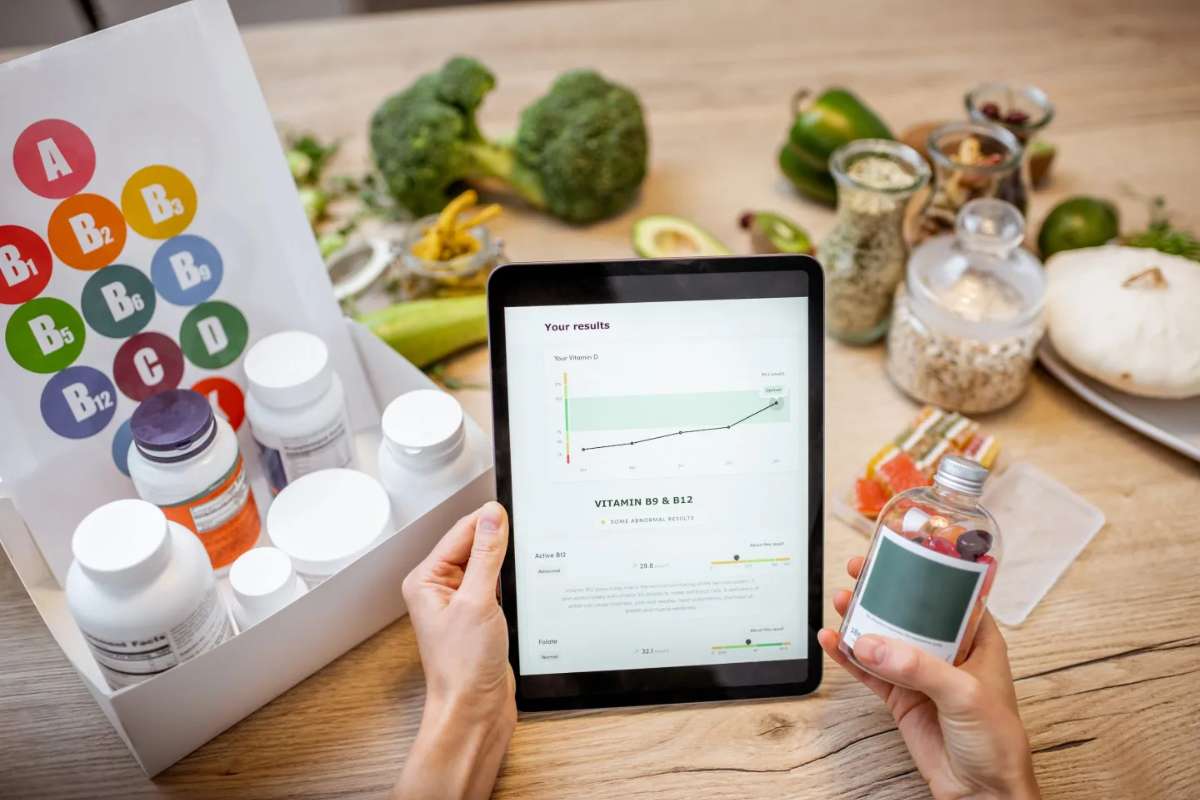
Starting your biohacking journey doesn’t require a laboratory; it begins with small, informed steps. Here’s a beginner-friendly guide:
- Set Clear Goals: Identify what you want to optimise, energy, focus, sleep, or longevity. Clear objectives make it easier to choose the right types of biohacking.
- Track Key Metrics: Use wearables, sleep apps, or nutrition trackers to monitor your progress. Data-driven feedback ensures that interventions are effective and safe.
- Start Simple: Begin with accessible practices like intermittent fasting, optimised hydration, mindfulness exercises, and structured sleep routines.
- Gradually Experiment: Once comfortable, explore advanced options like nootropics, genetic testing, or cold exposure. Always prioritise safety and consult experts when necessary.
- Evaluate and Adjust: Regularly review data and outcomes. Effective biohacking requires iteration and personalisation, not rigid adherence to trends.
- Stay Informed: Follow credible research, biohacking communities, and health professionals to adopt scientifically validated methods.
By combining beginner-friendly practices with careful experimentation, anyone can safely explore the diverse types of biohacking and integrate them into daily life.
Conclusion
Biohacking is more than a trend; it’s a toolkit for enhancing physical, mental, and cognitive performance. From nutritional tweaks and fitness optimisation to neurohacking and genetic insights, the types of biohacking offer multiple pathways for self-improvement.
While the potential is vast, success lies in responsible practice. Prioritising safety, evidence-based methods, and ethical considerations ensures that experimentation leads to meaningful, sustainable results.
As Dave Asprey, founder of Bulletproof, famously said:
“Biohacking isn’t about living longer; it’s about living better.”
Whether you’re an aspiring biohacker or simply curious, understanding the methods, benefits, and risks empowers you to take control of your biology, optimise performance, and embrace a lifelong journey of health and self-discovery.



